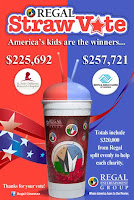Yesterday Regal Entertainment announced the final tally of its August Straw Vote; Boys and Girls Clubs of America garnered $97,721 and St. Jude Children’s Research Hospitals collected $65,692. Regal also split another $320,000 between the two causes.
In the promotion, which I highlighted on August 1, Regal donated $0.50 for each medium or large frozen fruit drink sold during the month. The purchase of cherry drinks supported St. Jude. The purchase of all other flavors supported Boys and Girls Club.
At the outset Regal capped the total donation to both causes at $600,000. But when all was said and done, Regal had donated $483,413 to the two causes. That suggests that Regal thought the promotion had more legs than it actually did.
Because 2013 is not an election year in the United States, it’s unlikely that Regal will repeat it next year, at least in this format. But that would be a pity, in my view.
Some things just take a while to catch on.
Actor Alan Rickman didn’t get his first movie role until he was 46. Author Joseph Conrad didn’t even speak English until adulthood. And until he published ‘Heart of Darkness’ at age 37 he was basically was a sailor, a drifter and small-time criminal. Harland Sanders didn’t open his first Kentucky Fried Chicken until he was 65. Tom Brady, the New England Patriot quarterback and a fifth round draft pick, has said that if he would have been drafted any higher, he almost certainly wouldn’t have had the time to develop or meet the expectations that come with being a high draft pick.
In other words, some things take time to achieve their full potential. Regal's straw vote may be one of those things.
In the promotion, which I highlighted on August 1, Regal donated $0.50 for each medium or large frozen fruit drink sold during the month. The purchase of cherry drinks supported St. Jude. The purchase of all other flavors supported Boys and Girls Club.
At the outset Regal capped the total donation to both causes at $600,000. But when all was said and done, Regal had donated $483,413 to the two causes. That suggests that Regal thought the promotion had more legs than it actually did.
Because 2013 is not an election year in the United States, it’s unlikely that Regal will repeat it next year, at least in this format. But that would be a pity, in my view.
Some things just take a while to catch on.
Actor Alan Rickman didn’t get his first movie role until he was 46. Author Joseph Conrad didn’t even speak English until adulthood. And until he published ‘Heart of Darkness’ at age 37 he was basically was a sailor, a drifter and small-time criminal. Harland Sanders didn’t open his first Kentucky Fried Chicken until he was 65. Tom Brady, the New England Patriot quarterback and a fifth round draft pick, has said that if he would have been drafted any higher, he almost certainly wouldn’t have had the time to develop or meet the expectations that come with being a high draft pick.
In other words, some things take time to achieve their full potential. Regal's straw vote may be one of those things.

Comments
I think the only thing that could make it better was if Regal had collected contact information from participants and provided it to St. Jude's and Boys and Girls Club so that they could re-engage with those customers after the campaign ended. SheerID has a tool that makes that possible.